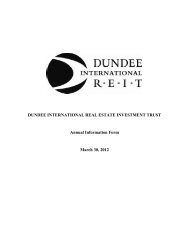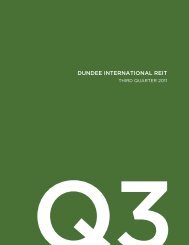Annual Report 2011 - Dundee International REIT
Annual Report 2011 - Dundee International REIT
Annual Report 2011 - Dundee International REIT
Create successful ePaper yourself
Turn your PDF publications into a flip-book with our unique Google optimized e-Paper software.
DUNDEE INTERNATIONAL <strong>2011</strong> <strong>Annual</strong> <strong>Report</strong><br />
The Trust reports its interests in jointly controlled entities using the equity method of accounting. Under the<br />
equity method, equity accounted investments are carried on the consolidated balance sheet at cost, adjusted<br />
for the Trust’s proportionate share of post-acquisition profits and losses, and for post-acquisition changes in<br />
excess of the Trust’s carrying amount of its investment over the net assets of the equity accounted investments,<br />
less any identified impairment loss. The Trust’s share of profits and losses is recognized in the share of net<br />
income/loss from equity accounted investments in the consolidated statement of comprehensive income. At<br />
each period-end, the Trust evaluates whether there is objective evidence that its interest in an equity accounted<br />
investment is impaired. The entire carrying amount of the equity accounted investment is compared to the<br />
recoverable amount, which is the higher of the value in use or fair value less costs to sell. The recoverable<br />
amount of each investment is considered separately. When the Trust’s share of losses of an equity accounted<br />
investment equals or exceeds its interest in that investment, the Trust discontinues recognizing its share of<br />
further losses. Any additional share of losses is provided for and a liability is recognized only to the extent<br />
that the Trust has incurred legal or constructive obligations to fund the entity or made payments on behalf of<br />
that entity. Accounting policies of equity accounted investments have been changed where necessary to<br />
ensure consistency with the policies adopted by the Trust.<br />
Where the Trust transacts with its equity investments, unrealized profits and losses are eliminated to the extent<br />
of the Trust’s interest in the investment. Balances outstanding between the Trust and equity accounted<br />
investments in which it has an interest are not eliminated in the consolidated balance sheet.<br />
Note 3<br />
ACCOUNTING POLICIES SELECTED AND APPLIED FOR SIGNIFICANT<br />
TRANSACTIONS AND EVENTS<br />
The significant accounting policies used in the preparation of these consolidated financial statements are<br />
described below:<br />
Investment properties<br />
Investment properties are initially recorded at cost, except if acquired in a business combination, in which case<br />
they are initially recorded at fair value, and include office, industrial and other commercial properties held to<br />
earn rental income and/or for capital appreciation. Investment properties are subsequently measured at fair<br />
value, determined based on available market evidence, at the consolidated balance sheet date. Related fair<br />
value gains and losses are recorded in comprehensive income in the period in which they arise. The fair value<br />
of each investment property is based on, among other things, rental income from current leases and<br />
assumptions about rental income from future leases reflecting market conditions at the consolidated balance<br />
sheet date, less future estimated cash outflows in respect of such properties. To determine fair value, the Trust<br />
first considers whether it can use current prices in an active market for a similar property in the same location<br />
and condition, and subject to similar leases and other contracts. The Trust has concluded there is insufficient<br />
market evidence on which to base investment property valuation using this approach, and has therefore<br />
determined that the use of the income approach is more appropriate. The income approach is one in which the<br />
fair value is estimated by capitalizing the net operating income that the property can reasonably be expected<br />
to produce over its remaining economic life. The income approach is derived from two methods: the overall<br />
capitalization rate method whereby the net operating income is capitalized at the requisite overall capitalization<br />
rate; and/or the discounted cash flow method in which the income and expenses are projected over the<br />
anticipated term of the investment plus a terminal value discounted using an appropriate discount rate.<br />
Valuations of investment properties are most sensitive to changes in discount rates and capitalization rates.<br />
Initial direct leasing costs incurred in negotiating and arranging tenant leases are added to the carrying amount<br />
of investment properties. Lease incentives, which include costs incurred to make leasehold improvements to<br />
tenants’ space and cash allowances provided to tenants, are added to the carrying amount of investment<br />
PAGE 40






